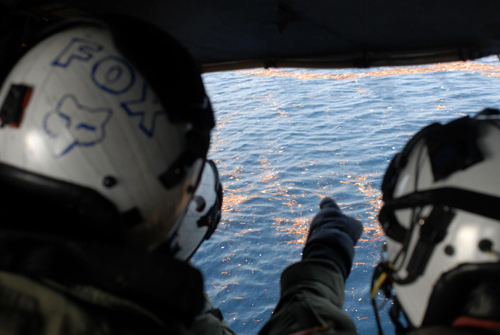Asia
After tsunami, one village vanishes
Updated: 2011-03-15 09:45
(Agencies)
Abe pointed to a battered concrete foundation amid the flattened landscape. It was his own house. "I will rebuild it," he said, "but not here."
Today, everything in Saito is spoken about in the past tense.
"That was city hall," said 48-year-old construction worker Takao Oyama, gesturing toward a two-story white building that stood alone near the beach, leaning at an angle into a sheet of mud and sand.
|
 Debris is pictured floating in the Pacific Ocean, in this photograph taken on March 13, 2011 and released on March 14. [Photo/Agencies] |
"That was our elementary school," he said, pointing to a three-story building a few hundred yards away whose entire facade had been ripped off and was covered in black and yellow ocean buoys. Most everything else has disappeared.
"We struggled, but it is all gone," Oyama said. "Everything is lost."
Behind him, a tranquil tree-covered island could be seen just off the coast. That such violence could come from such a picturesque view seemed contradictory, hard to believe.
One crumpled sign indicated there had once been a train station here, a fact Abe confirmed. It was hard to tell where, though. There were no tracks, no trains, no station.
Crushed bulldozers had been turned upside down. The blue-tiled roof of one house lay across a bridge. The wheels of a vehicle stuck out from under the roof.
A few yards away, a bloated black-spotted white cow lay on the foundation of another vanished home, streams of dried blood running from its pink nose, its eyes looking out over the destruction. Embedded in the hardened silt nearby lay a blue baby stroller, covered in what looked like hay.
"We can never live here again," Oyama said as he rested with his wife on a concrete ledge of the broken tarmac road. During an interview, the ledge trembled as another aftershock hit the region.
|
 Naval air crewmen assigned to the Black Knights of Helicopter Anti-Submarine Squadron inspect debris drifting in the Pacific Ocean from an 8.9 magnitude earthquake and subsequent tsunami that struck northern Japan in this U.S. Navy handout photo dated March 13, 2011. [Photo/Agencies] |
Asked how many people died, Oyama shrugged. "We've only seen a few bodies here," he said. "I think everybody was swept out to sea."
In the wider region of Minamisanrikucho, of which Saito is just one coastal village, Abe cited authorities as saying at least 4,500 of the 17,000 inhabitants were believed dead. Police estimated 10,000 dead among the 2.3 million people in the Miyagi prefecture, the Japanese equivalent of a state.
The firefighters who arrived Monday came from an inland town to pick through the rubble. Wearing goggles and dust masks, they carried long pickaxes, chainsaws and backpacks. They looked like spacemen walking across a gigantic lunar garbage dump.
As a Japanese self-defense force helicopter circled overhead, they lifted one hunched and frozen corpse from the mud of a dried canal filled with smashed cars and twisted mountains of corrugated iron sheeting. The tsunami had pulled the dead man's dark blue plaid shirt over his head. His white knuckles were visible, his hand still clenched.
The firefighters covered him in a blue plastic tarp and carried him away on a stretcher. Later, they found another corpse in the rubble and carted that one away, too.
The road that winds through Saito is broken apart in several spots. At one point _ where the tsunami wave stopped _ it leads into a quiet neighborhood of another village where two-story houses stand perfectly intact, their windows not even shattered _ as if nothing ever happened.
There, on the pavement, in front of a small government house-turned-shelter where survivors rested on tatami mats, somebody had scrawled huge white letters in the road for air crews to see: SOS.
Specials

Earthquake Hits Japan
A massive 8.8 magnitude quake hit the northeast coast of Japan on March 11,2011.

NPC & CPPCC sessions
Lawmakers and political advisers gather in Beijing to discuss major issues.

Labor crunch
Worker scarcity is no longer confined to eastern areas, minister says.